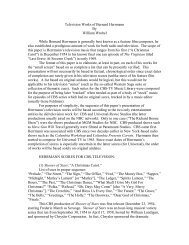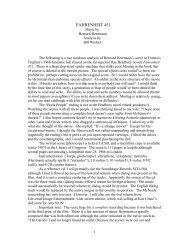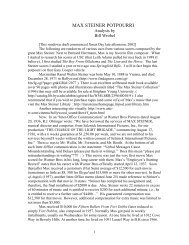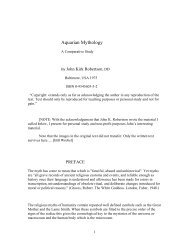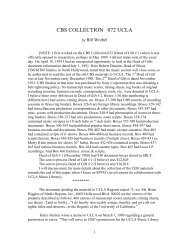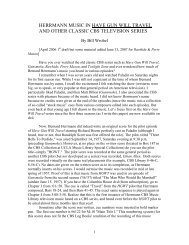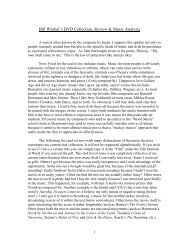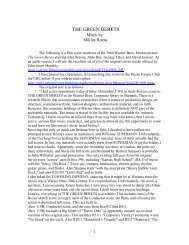Valentine's Day, Sunday, February 14, 2010 at 10:20 am
Valentine's Day, Sunday, February 14, 2010 at 10:20 am
Valentine's Day, Sunday, February 14, 2010 at 10:20 am
- No tags were found...
You also want an ePaper? Increase the reach of your titles
YUMPU automatically turns print PDFs into web optimized ePapers that Google loves.
While Herrmann was not the King of the Volcanoes, he was definitely the King of Self-Borrowings. Steiner was no slouch in this area either, but Herrmann was the King. And itappears (unless Herrmann had perfect memory) th<strong>at</strong> he leafed thru his old Early Worksand found wh<strong>at</strong> he wanted for this cue (or first vaguely remembered wh<strong>at</strong> it was and thengot it from his collection). After all he utilized the precisely s<strong>am</strong>e notes--although"cre<strong>at</strong>ively" altered the time sign<strong>at</strong>ure.Now: Here is a more complete view of th<strong>at</strong> Body Beautiful visual:{Image http://img19.imageshack.us/img19/1919/r<strong>10</strong>a0001.jpgHerrmann develops th<strong>at</strong> fanfare whereas it is not developed in SINBAD (nor "Egypt"after the first three bars th<strong>at</strong> I recall).Specifically the cue Bill Stromberg is referring to inThe 7th Voyage of Sinbad is called "The Trumpets" (R2/4), Bars 2-4. Unfortun<strong>at</strong>ely I donot have a visual for it. However, while the time sign<strong>at</strong>ure is 4/4 in the Early Worksversions of this theme, Herrmann applied the 3/4 time sign<strong>at</strong>ure to it, so it doesn't havethe s<strong>am</strong>e "look" initially. But it will virtually "sound" the s<strong>am</strong>e, and indeed, the notes orpitches are exactly the s<strong>am</strong>e in the SINBAD version as Body Beautiful. So instead of thel<strong>at</strong>ter's D up to A quarter notes to s<strong>am</strong>e D half note, we have D up <strong>at</strong> A 8ths to A quarternote, and so forth.I <strong>am</strong> trying to determine from my notes th<strong>at</strong> Early Work of the two c<strong>am</strong>e first....Immedi<strong>at</strong>ely below is Section E (page 8) of BODY BEAUTIFUL, "Danse Lento"tempo-marking:{Image http://img39.imageshack.us/img39/558/r11a0001.jpgImmedi<strong>at</strong>ely below is the image of pages 4-5 (especially page 5) of BODYBEAUTIFUL:{Image http://img11.imageshack.us/img11/8036/r13a0001.jpg_______________________________________________talkingherrmann mailing list***********************************Tuesday, <strong>10</strong>-<strong>20</strong>-09:Talking Herrmann: Box 68 UCSB 'Joy in the Morning'Reply by: Bill Wrobel ()______________________________________________________________________Notice the f<strong>am</strong>ous or oft-used tritone of F# up to C (dim 5 version) or C up to F# (aug 4thversion) is used in the Prelude of TMWKTM, played prominently by the timp, seen in the133




